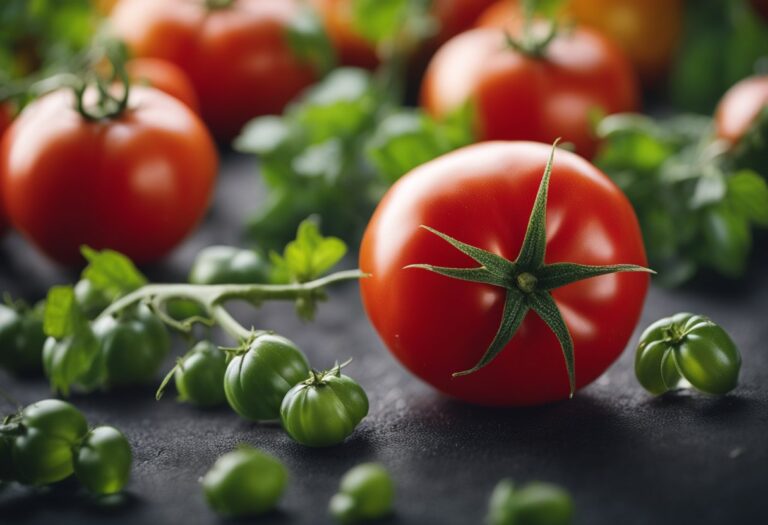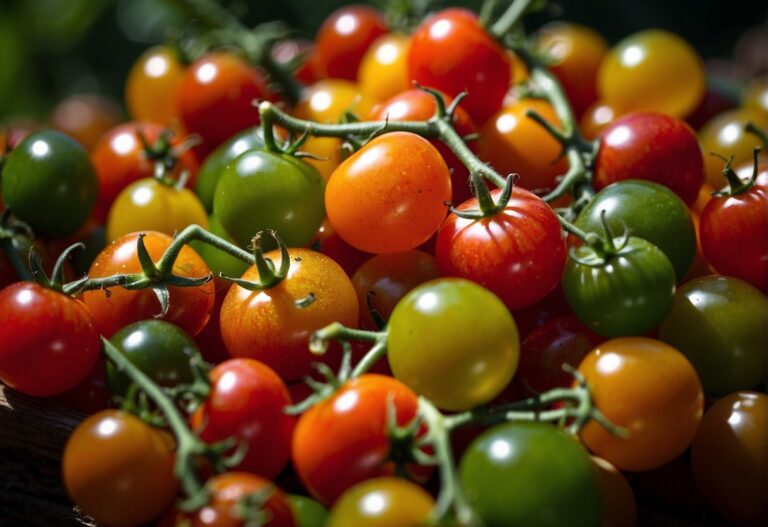Jet Star Tomato Problems: Common Issues and Solutions
Jet Star tomatoes are a popular variety of tomato that are known for their high yields and disease resistance. However, like any plant, Jet Star tomatoes can experience problems that can affect their growth and yield.
In this article, you will learn about common Jet Star tomato problems and how to prevent and treat them.
Understanding Jet Star Tomato Before we dive into common problems, it’s important to understand the characteristics of Jet Star tomatoes. They are known for their prolific fruit production and bountiful yields.
The fruits mature early, meaning 72 days is the longest you’ll ever have to wait for your bumper harvest. The plant also grows well in a wide variety of climates. Knowing these characteristics will help you identify when something is wrong with your Jet Star tomato plant.
Common Jet Star Tomato Problems Some common problems that Jet Star tomato plants can experience include blossom end rot, cracking, splitting, yellowing leaves, and pests such as aphids and whiteflies.
These problems can be caused by a variety of factors, including overwatering, underwatering, nutrient deficiencies, and environmental factors such as temperature and humidity. In the next section, we will discuss how to prevent and treat these problems.
Key Takeaways
- Jet Star tomatoes are known for their high yields and disease resistance.
- Common problems include blossom end rot, cracking, splitting, yellowing leaves, and pests such as aphids and whiteflies.
- Prevent and treat problems by maintaining proper watering, fertilization, and environmental conditions, and using natural pest control methods.
Understanding Jet Star Tomato
If you’re planning to grow Jet Star tomatoes, it’s important to understand their characteristics and potential problems. Here’s what you need to know:
Characteristics
- Jet Star tomatoes are a hybrid variety known for their disease resistance and crack resistance.
- They are an early season tomato that takes about 72 days to mature.
- Jet Star tomatoes are determinate, meaning they will grow to a certain size and then stop.
- The plants are compact and produce fruits that are about 4 ounces each.
- The texture of a Jet Star tomato is firm and meaty, making it ideal for slicing, cubing, and other raw enjoyment.
- The taste profile of this tomato is sweet and low in acidity.
Potential Problems
- Jet Star tomatoes are prone to blossom end rot, a condition caused by a lack of calcium in the soil. To prevent this, make sure your soil is rich in calcium and maintain consistent moisture levels.
- They are also susceptible to early blight, a fungal disease that causes yellowing and wilting of the leaves. To prevent this, avoid overhead watering and maintain good air circulation around the plants.
- Jet Star tomatoes can also be affected by spider mites, aphids, and whiteflies. Keep an eye out for these pests and take action promptly if you notice any signs of infestation.
- Finally, Jet Star tomatoes are determinate, meaning they will stop growing at a certain point. If you want a longer harvest period, consider planting a few Jet Star plants at different times throughout the season.
Overall, Jet Star tomatoes are a great choice for gardeners looking for a disease-resistant, crack-resistant, and flavorful tomato variety.
By understanding their characteristics and potential problems, you can ensure a successful harvest and enjoy delicious tomatoes all season long.
Common Jet Star Tomato Problems
Growing Jet Star tomatoes can be a rewarding experience, but like any crop, it can come with its challenges. Here are some common problems you may encounter when growing Jet Star tomatoes:
1. Cracking
Jet Star tomatoes are known for their crack-resistant properties, but that doesn’t mean they are immune to cracking. Cracking occurs when the fruit grows too quickly, causing the skin to split.
This can happen during periods of heavy rain or inconsistent watering. To avoid cracking, make sure to water your plants regularly and evenly.
If you do notice cracking, it’s best to harvest the fruit as soon as possible before it becomes infected with bacteria or fungus.
2. Blossom End Rot
Blossom end rot is a common problem for all tomato varieties, including Jet Star. It occurs when there is a calcium deficiency in the plant, causing the bottom of the fruit to turn black and mushy.
To prevent blossom end rot, make sure your soil has enough calcium by adding lime or gypsum. You can also try to maintain consistent soil moisture levels and avoid over-fertilizing your plants.
3. Yellowing Leaves
Yellowing leaves can be a sign of a few different problems, including nutrient deficiencies, pests, or diseases. If you notice yellowing leaves on your Jet Star tomato plants, try to identify the underlying cause.
It could be due to a lack of nitrogen, which can be remedied with a nitrogen-rich fertilizer. Alternatively, it could be caused by pests like aphids or whiteflies, which can be controlled with insecticidal soap or neem oil.
4. Fusarium Wilt
Fusarium wilt is a fungal disease that affects many tomato varieties, including Jet Star. It causes the leaves to turn yellow and wilt, and can eventually kill the entire plant.
Unfortunately, there is no cure for fusarium wilt, so prevention is key. Make sure to rotate your crops every year to prevent the disease from building up in the soil. You can also try to plant fusarium-resistant varieties or use fungicides as a preventative measure.
By being aware of these common Jet Star tomato problems and taking steps to prevent and treat them, you can ensure a healthy and bountiful harvest of delicious tomatoes.
Preventing and Treating Jet Star Tomato Problems
If you’re growing Jet Star tomatoes, it’s important to be aware of the potential problems that can arise. Here are some tips to help prevent and treat common Jet Star tomato problems:
Disease Prevention
Jet Star tomatoes are known for their disease resistance, but they can still be susceptible to certain diseases. Here are some things you can do to prevent disease:
- Rotate your crops: Avoid planting tomatoes in the same spot for two years in a row to prevent soil-borne diseases.
- Choose disease-resistant varieties: Jet Star is already resistant to Fusarium and Verticillium wilt, but there are other diseases that it may not be resistant to.
- Keep your plants healthy: Make sure your plants are getting enough water and nutrients to keep them strong and healthy.
Pest Prevention
Pests can also be a problem for Jet Star tomatoes. Here are some tips for preventing pests:
- Keep your garden clean: Remove any debris and weeds from your garden to eliminate hiding spots for pests.
- Use natural pest control methods: Consider using natural pest control methods like companion planting and beneficial insects to keep pests at bay.
- Inspect your plants regularly: Check your plants regularly for signs of pests and treat them immediately if you notice any problems.
Treatment Options
Even with preventative measures, you may still encounter problems with your Jet Star tomatoes. Here are some treatment options for common issues:
- Blossom end rot: This is a common problem that can be caused by a calcium deficiency. Treat it by adding calcium to the soil or using a calcium spray.
- Tomato hornworms: These pests can be treated with Bacillus thuringiensis (Bt), a natural insecticide that targets caterpillars.
- Blight: This is a fungal disease that can be treated with fungicides like copper sulfate or chlorothalonil.
By following these tips, you can help prevent and treat common Jet Star tomato problems, ensuring a healthy and productive harvest.
Best Practices for Growing Jet Star Tomatoes
If you want to grow Jet Star tomatoes successfully, there are a few best practices you should keep in mind. Here are some tips to help you get the most out of your plants:
Choose the Right Location
Jet Star tomatoes need plenty of sunlight to grow and produce fruit. Choose a location that gets at least six hours of direct sunlight every day.
Make sure the soil is well-draining and rich in organic matter. Avoid planting Jet Star tomatoes in areas that are prone to flooding or standing water.
Plant at the Right Time
Jet Star tomatoes are warm-weather plants and should be planted after the last frost in your area. Plant them when the soil temperature is at least 60°F (16°C).
If you live in a cooler climate, you can start your Jet Star tomato seeds indoors 6-8 weeks before the last frost and transplant them outdoors when it warms up.
Provide Adequate Support
Jet Star tomatoes can grow up to 5 feet tall and will need support to keep them from falling over. Use stakes, cages, or trellises to support your plants.
Make sure the support is sturdy enough to hold the weight of the plant and fruit.
Water Consistently
Jet Star tomatoes need consistent moisture to grow and produce fruit. Water them deeply once a week, or more often if the weather is hot and dry. Avoid getting water on the leaves, as this can lead to disease.
Fertilize Regularly
Jet Star tomatoes are heavy feeders and need regular fertilization to thrive. Use a balanced fertilizer, such as a 10-10-10 or 5-10-5, every 2-3 weeks.
Follow the instructions on the package carefully and avoid over-fertilizing, as this can lead to excessive foliage growth and poor fruit production.
Watch for Pests and Diseases
Jet Star tomatoes are susceptible to a variety of pests and diseases, including aphids, tomato hornworms, Fusarium wilt, and Verticillium wilt.
Keep an eye out for signs of infestation or disease and take action immediately if you notice anything. Use organic pest control methods whenever possible, such as handpicking pests or using insecticidal soap.
By following these best practices, you can grow healthy, productive Jet Star tomato plants that produce plenty of delicious fruit. Happy gardening!
Frequently Asked Questions
What are some disease-resistant tomato varieties similar to Jet Star?
If you’re looking for disease-resistant tomato varieties similar to Jet Star, consider trying out Mountain Fresh Plus, Celebrity, or Better Boy.
These varieties are known for their resistance to common tomato diseases such as Fusarium wilt and Verticillium wilt, just like Jet Star.
How long does it take for Jet Star tomatoes to mature?
Jet Star tomatoes typically take 70-80 days to mature from the time they are planted.
However, this can vary depending on the climate and growing conditions in your area. Keep an eye on the tomatoes and harvest them when they are fully ripe for the best flavor.
What are some tips for pruning Jet Star tomato plants?
Pruning Jet Star tomato plants can help increase airflow and sunlight exposure to the fruit, leading to better yields and healthier plants.
When pruning, be sure to remove any suckers that grow in the crotch between the stem and a branch. Additionally, remove any lower branches that are touching the ground to prevent disease and pests from spreading.
Where can I buy Jet Star tomato plants?
Jet Star tomato plants can be purchased at many garden centers and nurseries. Additionally, you can find them online at retailers such as Burpee or Johnny’s Selected Seeds.
Are Jet Star tomatoes good for saving seeds?
Jet Star tomatoes are a hybrid variety, which means that the seeds saved from them will not produce plants that are identical to the parent plant.
For this reason, it is not recommended to save seeds from Jet Star tomatoes if you want to ensure the same quality and characteristics in future plants.
How tall can Jet Star tomato plants grow?
Jet Star tomato plants are determinate, which means that they will grow to a certain height and then stop.
Typically, Jet Star plants will grow to be around 3-4 feet tall, making them a great choice for container gardening or for smaller garden spaces.


